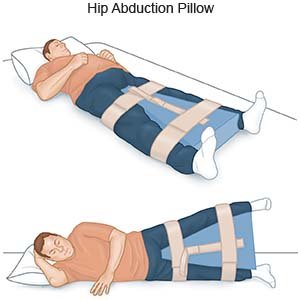Hip Abduction Pillow
Medically reviewed by Drugs.com. Last updated on Aug 4, 2025.
What is a hip abduction pillow?
A hip abduction pillow is a device used to prevent your hip from moving out of the joint. The pillow is placed between your thighs and attached to your legs with straps.
Why do I need to wear a hip abduction pillow?
A hip abduction pillow helps prevent your hip from turning in or away from your body. It will also keep your hip straight while you are in bed, even while you are asleep. The abduction pillow will hold your hip in one position and help it heal. You may need to wear a hip abduction pillow if your hip moved out of the joint or you have a hip fracture. It may also be used after surgery such as an open reduction and internal fixation (ORIF) or a hip arthroplasty. You may need to use a hip abduction pillow for several weeks.
Related medications
How do I place a hip abduction pillow properly?
Your healthcare provider will teach you how to place a hip abduction pillow. Your provider may give you the following instructions:
- Lie flat on the bed.
- Place the pillow between your thighs. The pillow should touch each leg from your thigh to your ankles. Your legs will fit inside spaces on the sides of the foam pillow.
- You will need a caregiver to attach the pillow to your thighs and ankles. A caregiver can be a family member or a friend that helps with your care. He or she will need to follow these steps:
- Wrap the straps around your thighs and ankles and attach to the pillow.
- Tighten the straps to prevent your legs from moving outward. He or she should be able to fit one finger between your legs and the straps.

What else do I need to know about a hip abduction pillow?
Your healthcare provider will instruct you and your caregiver on how to do the following:
- Care for your skin as directed. Your healthcare provider will show how to loosen the straps every 2 to 4 hours and check your skin for sore or red areas. Your skin can be washed around the pillow with soap and water. Your provider may prescribe powders or lotions that will prevent skin damage.
- Do exercises as directed. Your healthcare provider may instruct you to remove your pillow for exercise. Your provider may instruct you to wiggle your toes once every hour. This will help prevent blood clots and improve blood circulation in your legs. Exercise may prevent you from losing movement and strength in your hip.
- Change your position every 2 hours. Your healthcare provider will show you how to safely roll from side to side. This may prevent you from getting a bed sore on your buttocks or tailbone. It may also help you heal by moving blood through your legs. Before you move, check that your pillow is strapped to your thighs and ankles.
- Wear your hip abduction pillow while in bed as directed. Your healthcare provider will tell you when it is safe to remove your hip abduction pillow.
What else can I do to care for myself?
- Drink more liquids. Liquids help keep your body hydrated and prevent a blood clot in your leg. Ask how much liquid you should drink and which liquids are best for you.
- Avoid sitting upright with your legs out in front of you. If you sit upright, you may place too much stress on your hip or cause your hip to dislocate.
- Do not cross your legs or ankles. You may move your hip out of its joint.
Care Agreement
You have the right to help plan your care. Learn about your health condition and how it may be treated. Discuss treatment options with your healthcare providers to decide what care you want to receive. You always have the right to refuse treatment. The above information is an educational aid only. It is not intended as medical advice for individual conditions or treatments. Talk to your doctor, nurse or pharmacist before following any medical regimen to see if it is safe and effective for you.© Copyright Merative 2025 Information is for End User's use only and may not be sold, redistributed or otherwise used for commercial purposes.
Further information
Always consult your healthcare provider to ensure the information displayed on this page applies to your personal circumstances.
